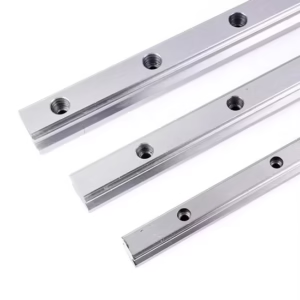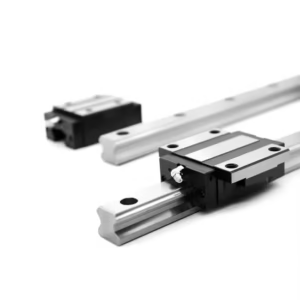Outline for Linear Rail
| Main Topic | Subtopics |
|---|---|
| Introduction to Linear Rail | Definition, Importance, History of linear motion systems |
| How Linear Rails Work | Design principle, Rail and carriage system, Rolling elements |
| Types of Linear Rails | Profiled linear rails, Round shaft rails, Roller-type rails, Ball-type rails |
| Materials Used in Linear Rails | Steel, Stainless steel, Coated rails, Polymers |
| Design Features of Linear Rails | Load capacity, Accuracy, Rigidity, Lifespan |
| Advantages of Linear Rail | Precision, Smooth motion, Long service, High load capacity |
| Limitations of Linear Rail | Cost, Installation complexity, Maintenance requirements |
| Applications of Linear Rail | CNC machines, 3D printers, Robotics, Aerospace, Medical equipment |
| Linear Rail vs. Linear Bearing | Differences, When to use each |
| Linear Rail vs. Linear Guide | Similarities and differences |
| Choosing the Right Linear Rail | Load requirements, Speed, Operating environment, Budget |
| Installation Best Practices | Rail mounting, Alignment, Avoiding mistakes |
| Maintenance of Linear Rail | Cleaning, Lubrication, Inspections |
| Lubrication in Linear Rail | Oil, Grease, Dry lubrication |
| Friction and Wear in Linear Rail | Causes, Prevention, Solutions |
| Troubleshooting Linear Rail Issues | Noise, Binding, Misalignment, Excessive wear |
| Linear Rails in CNC Machines | Importance, Accuracy, Productivity |
| Linear Rails in 3D Printing | Motion precision, Print quality, Stability |
| Linear Rails in Robotics | Role in automation, Accuracy, Case examples |
| Linear Rails in Medical Equipment | Imaging devices, Surgical robots, Lab automation |
| Market Trends in Linear Rail | Industry growth, Key manufacturers, Emerging technologies |
| Future of Linear Rail | IoT integration, Smart monitoring, Nanotech applications |
| DIY Projects with Linear Rail | CNC builds, Camera sliders, DIY robotics |
| Cost of Linear Rail | Pricing ranges, Factors affecting costs |
| Eco-Friendly Aspects of Linear Rail | Sustainable materials, Energy efficiency |
| FAQs on Linear Rail | Common questions with detailed answers |
| Conclusion on Linear Rail | Key takeaways and future outlook |
Introduction to Linear Rail
A linear rail is a mechanical system designed to guide and support precise linear motion. It consists of a rail and a carriage (or block) that moves along it, supported by rolling elements such as balls or rollers. Linear rails are fundamental to modern engineering, where accuracy, stability, and smooth movement are essential.
From CNC machining and robotics to aerospace systems and medical devices, linear rails are everywhere. They provide rigid guidance and high load capacity, making them indispensable in automation and precision manufacturing.
Historically, engineers relied on sliding mechanisms with bushings for linear movement. While functional, they suffered from friction, wear, and misalignment issues. The advent of rolling-element linear rails in the 20th century transformed industries, enabling faster, longer-lasting, and more precise machines.
How Linear Rails Work
Linear rails function using a sliding carriage on a rigid rail, supported by recirculating rolling elements.
- The rail provides a precisely machined surface for straight movement.
- The carriage (or block) contains ball bearings or rollers.
- As the block moves, the rolling elements circulate within the block, ensuring low-friction and stable movement.
This design achieves smooth, accurate, and repeatable motion while withstanding heavy loads and vibrations.
Types of Linear Rails
- Profiled Linear Rails – Rectangular or square cross-section, excellent for rigidity and accuracy.
- Round Shaft Rails – Cylindrical, easy to install, lower rigidity.
- Roller-Type Rails – Use rollers for high load capacity and rigidity.
- Ball-Type Rails – Use recirculating balls for smooth, precise motion.
Materials Used in Linear Rails
- Steel: High strength and load capacity.
- Stainless Steel: Corrosion resistance, ideal for medical and food-grade applications.
- Coated Rails: Extra wear resistance and longer life.
- Polymer Rails: Lightweight, low-cost, used in light-duty systems.
Design Features of Linear Rails

- Load Capacity: Handles both vertical and horizontal forces.
- High Accuracy: Maintains precise movement.
- Rigidity: Prevents deflection under heavy loads.
- Durability: Long life under continuous operation.
Advantages of Linear Rail
- High precision motion with minimal deviation.
- Smooth travel with reduced friction.
- Handles heavy loads without bending.
- Long service life with proper maintenance.
Limitations of Linear Rail
- Higher cost than simple bearing systems.
- Installation requires precision.
- Regular lubrication and maintenance are essential.
Applications of Linear Rail
- CNC Machines: Ensures cutting accuracy and stability.
- 3D Printers: Enables smooth layer deposition.
- Robotics: Provides precision in automated systems.
- Aerospace: Used in testing and navigation systems.
- Medical Devices: Applied in imaging and surgical systems.
Linear Rail vs. Linear Bearing
- Linear Rails: Provide both rigidity and motion support.
- Linear Bearings: Focus more on smooth movement but less rigid.

Linear Rail vs. Linear Guide
- Often used interchangeably, but guide rails emphasize stability, while linear rails emphasize precision motion.
Choosing the Right Linear Rail
- Load handling needs.
- Speed and precision requirements.
- Environmental conditions (dust, humidity, cleanliness).
- Budget considerations.
Installation Best Practices
- Ensure rail alignment.
- Use precision mounting bolts.
- Avoid forcing carriages during installation.
Maintenance of Linear Rail
- Regular cleaning to prevent dust buildup.
- Lubrication schedules depending on workload.
- Periodic inspections to detect wear early.
Lubrication in Linear Rail
- Grease lubrication: Long-lasting.
- Oil lubrication: High-speed operations.
- Self-lubricating options: Maintenance-free.
Friction and Wear in Linear Rail
- Causes: Misalignment, lack of lubrication, contamination.
- Prevention: Regular maintenance, high-quality lubricants, proper installation.
Troubleshooting Linear Rail Issues
- Noise: Usually due to poor lubrication.
- Binding: Caused by misalignment.
- Vibration: Uneven load distribution.
- Excessive wear: Overloading or contamination.
Linear Rails in CNC Machines
- Ensure cutting precision and rigidity.
- Handle high-speed machining.
- Improve productivity and repeatability.
Linear Rails in 3D Printing
- Deliver smooth, precise motion.
- Improve print quality and consistency.
- Extend printer lifespan.
Linear Rails in Robotics
- Enable accurate, repeatable movements.
- Support automation efficiency.
- Used in industrial robotic arms and sliders.
Linear Rails in Medical Equipment
- Found in MRI, CT, and surgical robotics.
- Used in diagnostic imaging machines.
- Important for laboratory automation systems.
Market Trends in Linear Rail
- Growing adoption in automation and robotics.
- Emerging self-lubricating and smart rails.
- Key players: THK, NSK, Bosch Rexroth, SKF.
Future of Linear Rail
- IoT-enabled smart monitoring.
- Nanotechnology for precision.
- Advanced eco-friendly coatings.
DIY Projects with Linear Rail

- DIY CNC routers.
- Camera sliders for filmmaking.
- Custom robotic arms.
Cost of Linear Rail
- Standard rails: $50–$200.
- Heavy-duty rails: $300–$1,000.
- Specialized rails: Several thousand dollars.
Eco-Friendly Aspects of Linear Rail
- Made with recyclable materials.
- Improve energy efficiency of machines.
- Use of green lubricants for sustainability.
FAQs on Linear Rail
What is a linear rail used for?
It guides and supports precise linear motion in machinery.
Do linear rails need lubrication?
Yes, unless they are self-lubricating designs.
How are linear rails different from bearings?
Rails provide rigidity and support; bearings provide smooth sliding motion.
Are linear rails expensive?
They range from affordable hobbyist models to costly industrial ones.
How long do linear rails last?
With proper maintenance, they last years even in demanding use.
Which industries rely most on linear rails?
Manufacturing, aerospace, robotics, and healthcare.
Conclusion on Linear Rail
A linear rail is the backbone of modern precision engineering. Whether in CNC machining, robotics, 3D printing, or medical technology, linear rails ensure smooth, rigid, and highly accurate motion.
As industries evolve, smart sensors, IoT integration, and advanced materials will drive the next generation of linear rails, making them more durable, intelligent, and eco-friendly. For engineers and innovators, mastering linear rail technology means unlocking the future of automation and efficiency.
Suggested Inbound Links
- CNC Machine Guide
- Robotics Automation Basics
- Precision Engineering Components

